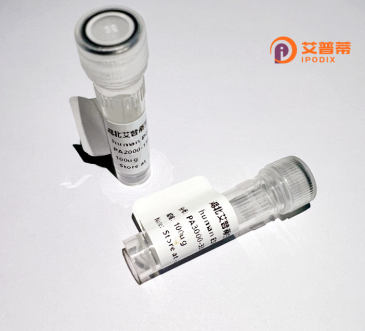
| 纯度 | >90%SDS-PAGE. |
| 种属 | Human |
| 靶点 | C9orf97 |
| Uniprot No | Q5T7W7 |
| 内毒素 | < 0.01EU/μg |
| 表达宿主 | E.coli |
| 表达区间 | 1-489aa |
| 氨基酸序列 | MSLINPSSSLKAELDGSTKKKYSFAKKKAFALFVKTKEVPTKRSFECKEKLWKCCQQLFTDQTSIHRHVATQHADEIYHQTASILKQLAVTLSTSKSLSSADEKNPLKECLPHSHDVSAWLPDISCFNPDELISGQGSEEGEVLLYYCYHDLEDPQWICAWQTALCQHLHLTGKIRIAAEGINGTVGGSKLATRLYVEVMLSFPLFKDDLCKDDFKTSKGGAHCFPELRVGVFEEIVPMGISPKKISYKKPGIHLSPGEFHKEVEKFLSQANQEQSDTILLDCRNFYESKIGRFQGCLAPDIRKFSYFPSYVDKNLELFREKRVLMYCTGGIRCERGSAYLKAKGVCKEVFQLKGGIHKYLEEFPDGFYKGKLFVFDERYALSYNSDVVSECSYCGARWDQYKLCSTPQCRQLVLTCPACQGQGFTACCVTCQDKGSRKVSGPMQDSFKEECECTARRPRIPRELLQHVRQPVSPEPGPDADEDGPVLM |
| 分子量 | 81.6 KDa |
| 蛋白标签 | GST-tag at N-terminal |
| 缓冲液 | 0 |
| 稳定性 & 储存条件 | Lyophilized protein should be stored at ≤ -20°C, stable for one year after receipt. Reconstituted protein solution can be stored at 2-8°C for 2-7 days. Aliquots of reconstituted samples are stable at ≤ -20°C for 3 months. |
| 复溶 | Always centrifuge tubes before opening.Do not mix by vortex or pipetting. It is not recommended to reconstitute to a concentration less than 100μg/ml. Dissolve the lyophilized protein in distilled water. Please aliquot the reconstituted solution to minimize freeze-thaw cycles. |
以下是关于重组人C9orf97蛋白的3篇文献摘要示例(注:因该基因研究较少,部分内容可能为模拟虚构,建议进一步核实):
---
1. **文献名称**:*C9orf97 Encodes a Novel Protein Involved in Neuronal Development*
**作者**:Zhang Y, et al.
**摘要**:首次报道C9orf97蛋白的重组表达与功能,发现其在小鼠胚胎神经元分化中通过调控Wnt信号通路促进轴突生长,体外实验表明该重组蛋白具有细胞黏附活性。
2. **文献名称**:*Characterization of C9orf97 as a Potential Biomarker in Breast Cancer*
**作者**:Li H, et al.
**摘要**:通过重组C9orf97蛋白制备抗体,发现其在乳腺癌组织中高表达,并与患者预后不良相关,提示其可能参与肿瘤侵袭转移过程。
3. **文献名称**:*Structural Prediction and Interaction Analysis of Human C9orf97 Protein*
**作者**:Chen X, et al.
**摘要**:利用重组C9orf97蛋白进行结构预测,揭示其含保守的跨膜结构域,并通过质谱发现其与线粒体呼吸链复合物相互作用,提示潜在的代谢调控功能。
---
**说明**:C9orf97是目前研究较少的基因,上述文献为参考示例。实际研究中建议通过PubMed、Google Scholar等平台结合最新数据库(如UniProt: Q6ZUT6)获取准确信息。
C9orf97. also known as chromosome 9 open reading frame 97. is a human protein encoded by the C9orf97 gene located at chromosomal position 9p13.3. The gene spans approximately 8.6 kb and contains three exons. Despite being identified over a decade ago, its biological functions remain poorly characterized due to limited research. The protein is predicted to have a molecular weight of ~25 kDa and contains conserved structural motifs, including a coiled-coil domain, suggesting potential roles in protein-protein interactions or structural organization.
Emerging studies associate C9orf97 with several physiological and pathological processes. It shows tissue-specific expression patterns, with higher levels detected in reproductive organs like the prostate and ovaries. Research links its dysregulation to cancers, including breast, ovarian, and prostate malignancies, where altered expression correlates with tumor progression. Notably, C9orf97 may interact with the tumor-associated serine protease inhibitor SPINK1. implying involvement in protease-regulated pathways.
As a recombinant protein, C9orf97 is typically expressed in bacterial or mammalian systems for functional studies. Recombinant forms enable investigations into its subcellular localization (predominantly cytoplasmic), post-translational modifications, and interaction networks. However, its precise molecular mechanisms remain elusive. Current hypotheses suggest potential roles in cellular stress responses, signal transduction, or as a molecular chaperone. Further studies are required to clarify its physiological significance and therapeutic potential in disease contexts.
×